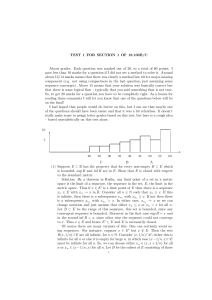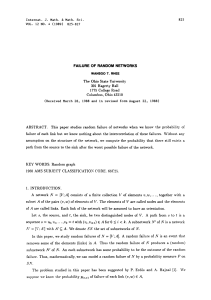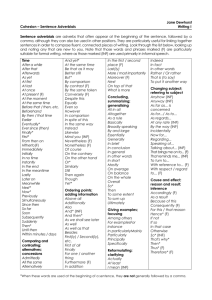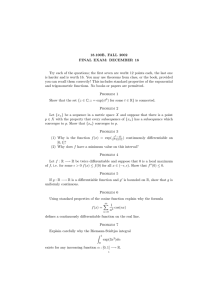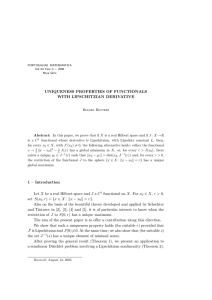HOMEWORK 7 FOR 18.100B/C, FALL 2010 DUE THURSDAY 4 NOVEMBER
advertisement
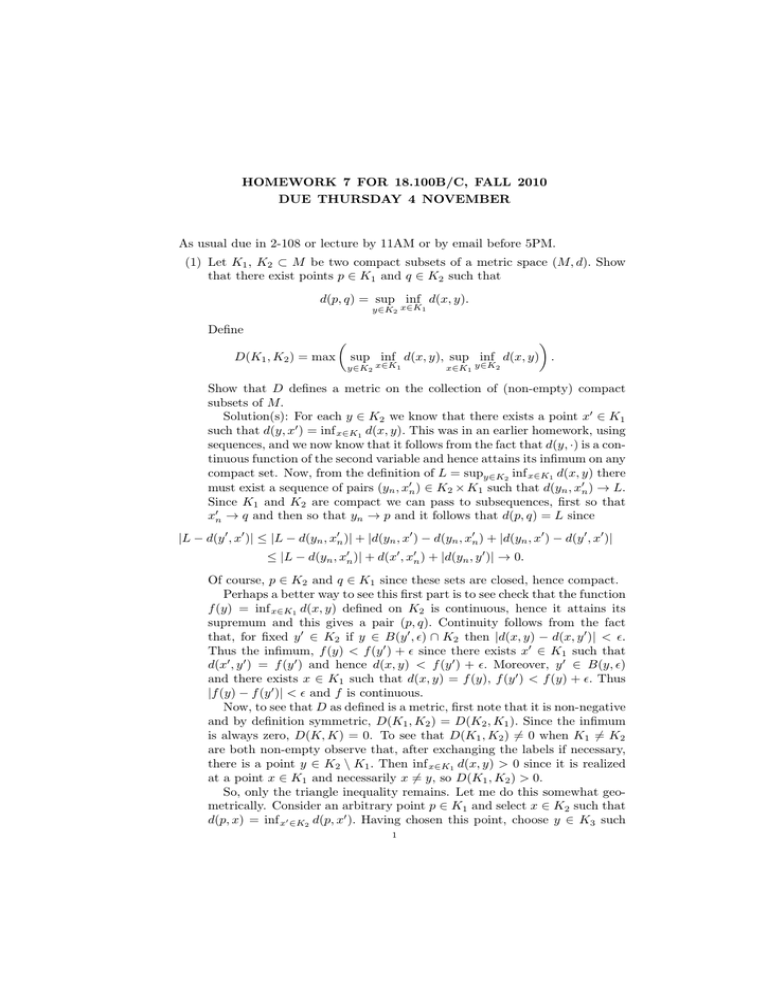
HOMEWORK 7 FOR 18.100B/C, FALL 2010 DUE THURSDAY 4 NOVEMBER As usual due in 2-108 or lecture by 11AM or by email before 5PM. (1) Let K1 , K2 ⊂ M be two compact subsets of a metric space (M, d). Show that there exist points p ∈ K1 and q ∈ K2 such that d(p, q) = sup inf d(x, y). y∈K2 x∈K1 Define D(K1 , K2 ) = max sup inf d(x, y), sup inf d(x, y) . y∈K2 x∈K1 x∈K1 y∈K2 Show that D defines a metric on the collection of (non-empty) compact subsets of M. Solution(s): For each y ∈ K2 we know that there exists a point x0 ∈ K1 such that d(y, x0 ) = inf x∈K1 d(x, y). This was in an earlier homework, using sequences, and we now know that it follows from the fact that d(y, ·) is a continuous function of the second variable and hence attains its infimum on any compact set. Now, from the definition of L = supy∈K2 inf x∈K1 d(x, y) there must exist a sequence of pairs (yn , x0n ) ∈ K2 × K1 such that d(yn , x0n ) → L. Since K1 and K2 are compact we can pass to subsequences, first so that x0n → q and then so that yn → p and it follows that d(p, q) = L since |L − d(y 0 , x0 )| ≤ |L − d(yn , x0n )| + |d(yn , x0 ) − d(yn , x0n ) + |d(yn , x0 ) − d(y 0 , x0 )| ≤ |L − d(yn , x0n )| + d(x0 , x0n ) + |d(yn , y 0 )| → 0. Of course, p ∈ K2 and q ∈ K1 since these sets are closed, hence compact. Perhaps a better way to see this first part is to see check that the function f (y) = inf x∈K1 d(x, y) defined on K2 is continuous, hence it attains its supremum and this gives a pair (p, q). Continuity follows from the fact that, for fixed y 0 ∈ K2 if y ∈ B(y 0 , ) ∩ K2 then |d(x, y) − d(x, y 0 )| < . Thus the infimum, f (y) < f (y 0 ) + since there exists x0 ∈ K1 such that d(x0 , y 0 ) = f (y 0 ) and hence d(x, y) < f (y 0 ) + . Moreover, y 0 ∈ B(y, ) and there exists x ∈ K1 such that d(x, y) = f (y), f (y 0 ) < f (y) + . Thus |f (y) − f (y 0 )| < and f is continuous. Now, to see that D as defined is a metric, first note that it is non-negative and by definition symmetric, D(K1 , K2 ) = D(K2 , K1 ). Since the infimum is always zero, D(K, K) = 0. To see that D(K1 , K2 ) 6= 0 when K1 6= K2 are both non-empty observe that, after exchanging the labels if necessary, there is a point y ∈ K2 \ K1 . Then inf x∈K1 d(x, y) > 0 since it is realized at a point x ∈ K1 and necessarily x 6= y, so D(K1 , K2 ) > 0. So, only the triangle inequality remains. Let me do this somewhat geometrically. Consider an arbitrary point p ∈ K1 and select x ∈ K2 such that d(p, x) = inf x0 ∈K2 d(p, x0 ). Having chosen this point, choose y ∈ K3 such 1 2 HOMEWORK 7 FOR 18.100B/C, FALL 2010 DUE THURSDAY 4 NOVEMBER that d(x, y) = inf y0 ∈K3 d(x, y 0 ). The triangle inequality gives d(p, y) ≤ d(p, x) + d(x, y) ≤ D(K1 , K2 ) + D(K2 , K3 ) since both terms on the right are infimums. Now, since y ∈ K3 , inf d(p, x) ≤ d(p, y) ≤ D(K1 , K2 ) + D(K2 , K3 ). z∈K3 Taking the supremum over p ∈ K1 then gives sup inf d(p, x) ≤ D(K1 , K2 ) + D(K2 , K3 ). p∈K1 z∈K3 Reversing the roles of K3 and K1 then shows that D(K1 , K3 ) ≤ D(K1 , K2 ) + D(K2 , K3 ). One does not need to go through the ‘geometrical picture’ if you are confident (competent?) with your infs and sups. Take the triangle inequality for an arbitrary triple, pi ∈ Ki : d(p1 , p3 ) ≤ d(p1 , p2 ) + d(p2 , p3 ). Now take the infimum of both sides over p3 ∈ K3 and use the definition of D to see that inf d(p1 , p3 ) ≤ d(p1 , p2 ) + inf d(p2 , p3 ) ≤ d(p1 , p2 ) + D(K2 , K3 ). p3 ∈K3 p3 ∈K3 Now we may take the infimum over p2 ∈ K2 since it only appears on the right to get inf d(p1 , p3 ) ≤ inf d(p1 , p2 ) + D(K2 , K3 ) ≤ D(K1 , K2 ) + D(K2 , K3 ) p3 ∈K3 p2 ∈K2 and then proceed as before – take the sup over p1 . (2) If f : [a, b] −→ R is differentiable (where a < b) and f 0 (x) 6= 0 for all x ∈ (a, b) show that f (b) 6= f (a). Solution. Since f is differentiable on [a, b] it is continuous on [a, b] by a Theorem in Rudin. The mean value theorem then shows that there exists x ∈ (a, b) such that f (b) − f (a) = f 0 (x)(b − a). Thus if f 0 (x) 6= 0 for all x ∈ (a, b) then f (b) 6= f (a). (3) Rudin Chap 5 No 4. If Ci for 0 ≤ i ≤ n are real constants such that C1 C2 Cn−1 Cn + + ··· + + =0 2 3 n n+1 show that the equation C0 + C0 + C1 x + C2 x2 + · · · + Cn xn = 0 has at least one real solution x in the interval (0, 1). Solution. The crucial obsevation is that if x2 x3 xn+1 p(x) = C0 x + C1 + C2 + · · · + Cn then 2 3 n+1 p0 (x) = C0 + C1 x + C2 x2 + · · · + Cn xn . Certainly p(0) = 0 and by assumption, p(1) = 0. As a polynomial, p : [0, 1] −→ R is (infinitely) differential, so by the mean value theorem there is a point x ∈ (0, 1) such that 0 = p(1) − p(0) = p0 (x)(1 − 0) = p0 (x) HOMEWORK 7 FOR 18.100B/C, FALL 2010 DUE THURSDAY 4 NOVEMBER 3 as desired. (4) Suppose f : R −→ R is differentiable and that f 0 (x) 6= 1 for all x ∈ R show that there can be at most one x ∈ R such that f (x) = x (‘a fixed point of f ’). Solution. Suppose there were two distinct points x1 < x2 with f (x1 ) = x1 and f (x2 ) = x2 . Since f is differentiable on the real line, the function g(x) = f (x) − x is continuous on [x1 , x2 ] and differentiable so by the mean value theorem there exists x ∈ (x1 , x2 ) such that 0 = g(x2 ) − g(x1 ) = g 0 (x)(x2 − x1 ) = (f 0 (x) − 1)(x2 − x1 ). By assumption, f 0 (x) 6= 1, so this is a contradiction and there can be at most one fixed point of f. (5) Rudin Chap 5 No 15. Suppose a ∈ R, f is a twice-differentiable real function on (a, ∞) and M0 , M1 and M2 are the suprema of |f (x)|, |f 0 (x)| and |f 00 (x)| on (a, ∞) (so all are assumed to be finite). Prove that M12 ≤ 4M0 M2 . [There is a hint in Rudin, namely Taylor’s theorem shows that given any h > 0 and x ∈ (a, ∞) there is ξ ∈ (x, x + 2h) such that 1 (f (x + 2h) − f (x)) − hf 00 (ξ). f 0 (x) = 2h Use this to show that |f 0 (x)| ≤ hM2 + Mh0 . For what value of h is the RHS smallest?] Solution. As Rudin suggests, using the twice-differentiability of f, which means that f 0 is differentiable, apply Taylor’s theorem with remainder term to see that for any h > 0 there exists ξ ∈ (x, x + 2h) such that 1 h2 00 f (ξ) =⇒ f 0 (x) = (f (x + 2h) − f (x)) − hf 00 (ξ). 2 2h Now use the definitions of M0 and M2 to see that M0 |f 0 (x)| ≤= + hM2 ∀h > 0. h If M2 = 0 then letting h → ∞ shows that f 0 (x) = 0 and similarly if M0 = 0 then letting h → 0 leads to the same conclusion. So we may set 1 −1 h = M02 M2 2 and deduce that f (x + 2h) = f (x) + 2hf 0 (x) + (1) 1 |f 0 (x)| ≤ 2(M0 M2 ) 2 . Taking the supremum over x ∈ (a, ∞) and squaring gives the desired estimate.


